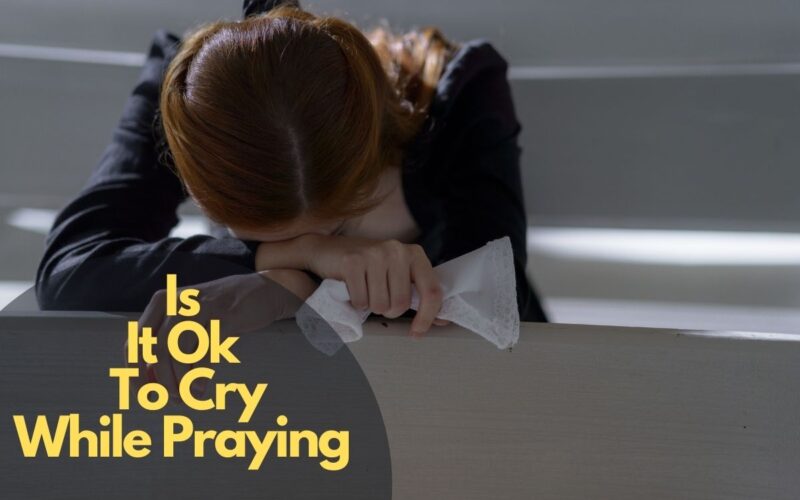Prayer is a deeply personal and emotional experience for many individuals. It is a time when people connect with their spirituality, seek solace, and express their innermost thoughts and feelings. In this article, we will explore the question of whether it is okay to cry while praying.
We will look into the significance of tears in religious practices, the emotional aspect of prayer, and the various perspectives surrounding this topic.
Is it OK to cry while praying?
Yes, it is okay to cry while praying. Emotions are a natural and genuine part of the human experience, and expressing them during prayer can be a deeply personal and cathartic experience. Tears can convey a range of emotions, from gratitude and joy to sorrow and desperation, enriching the sincerity of the prayerful connection.
Prayer is often associated with a range of emotions, including joy, gratitude, sorrow, and even grief. It serves as an outlet for individuals to express their deepest emotions and connect with a higher power or spiritual belief. The act of praying can be an intensely personal and emotional experience, and crying is one way in which people may release and express these emotions.
Another answer to the above question says that whether or not it’s okay to cry while praying depends largely on your personal beliefs and the context of your situation. In many traditions, it’s not only acceptable but seen as a natural and even positive expression of deep emotion and vulnerability.
Here are some perspectives to consider:
Religious Perspectives
- Christianity: In the Bible, there are many examples of people crying out to God in prayer, both in sorrow and in joy. Psalms are full of such heartfelt expressions. Crying is seen as a sign of humility and openness to God.
- Islam: Crying during prayer is not considered invalidating or wrong. It can be a sign of sincere devotion and a deep connection with Allah. However, excessive sobbing or wailing that disrupts the prayer itself might be discouraged.
- Judaism: Tears are seen as a powerful emotional response that can connect us to God. There are even specific prayers said while crying during difficult times.
- Buddhism: Crying can be a way to release suffering and negativity, leading to greater compassion and understanding. Tears are not something to be ashamed of but are seen as part of the human experience.
Psychological Perspective
Crying can be a healthy way to release emotions, both positive and negative. It can reduce stress, improve mood, and strengthen social bonds. When you cry during prayer, you’re allowing yourself to be vulnerable and authentic before your higher power, which can deepen your spiritual connection.
Ultimately, whether or not it’s okay to cry while praying is a personal decision. There are no right or wrong answers, and the most important thing is to be sincere and open to whatever emotions arise in your prayer.
Here are some additional things to consider:
- Focus on your intention: Are you crying out of sadness, joy, or overwhelm? Understanding your emotions can help you navigate your prayer experience.
- Respect your spiritual context. If you’re worried about how others might perceive your tears, consider praying in a private space or talking to a trusted religious leader for guidance.
- Don’t judge yourself: Crying is a natural human response, and there’s no shame in expressing your emotions during prayer.
The Significance of Tears in Religious Practices
Tears have held significant meaning in various religious and spiritual traditions throughout history. In some faiths, tears are seen as a form of purification, a way to cleanse the soul and seek forgiveness. They can also be viewed as a sign of deep devotion, humility, and surrender to a higher power. Crying during prayer can be seen as a genuine expression of one’s vulnerability, sincerity, and need for spiritual guidance.
Individual and Cultural Perspectives
The acceptability of crying while praying can vary depending on individual beliefs, cultural practices, and religious traditions. In some cultures, crying during prayer is seen as a natural and acceptable expression of emotion, while in others, it may be regarded as a sign of weakness or lack of control. It is essential to respect and understand the diverse perspectives and cultural nuances surrounding this topic.
Psychological and Therapeutic Effects
Crying has long been associated with psychological and therapeutic benefits. It can serve as a release valve for pent-up emotions, providing a sense of relief and catharsis. During prayer, crying can help individuals process their feelings, find comfort, and experience a sense of emotional healing. It can be a way to seek solace and find strength in times of distress or personal challenges.
Interpreting Crying During Prayer
The interpretation of crying during prayer can vary depending on the context and the individual’s intentions. Some may view it as a sign of spiritual connection, divine intervention, or an emotional breakthrough. Others may see it as a natural human response to the challenges and hardships of life. It is important to remember that the significance of crying during prayer may differ from person to person.
Acceptance and Support
It is crucial for individuals to feel accepted and supported in their religious practices, including the expression of emotions such as crying during prayer. Creating an environment that fosters empathy, understanding, and inclusivity can allow individuals to freely express their emotions and seek solace through prayer. Judgment and criticism should be replaced with compassion and respect.
Addressing Misconceptions and Stereotypes
There may be misconceptions or stereotypes associated with crying during prayer, particularly regarding gender roles or societal expectations. It is important to challenge and debunk these stereotypes, recognizing that emotions are a natural part of the human experience and should not be limited by societal norms. Allowing individuals to express themselves authentically can lead to a deeper and more meaningful spiritual connection.
Conclusion
The question, “Is it okay to cry while praying?” is less about seeking permission and more about understanding the authenticity of emotions within this intimate connection.
As we embrace the profundity of prayer, let us also embrace the authenticity of our emotions. Tears during prayer signify not weakness but a willingness to lay bare our innermost feelings.
They symbolize a genuine connection with our faith and a profound trust in the divine. In the end, it’s not about whether it’s “okay” to cry while praying; it’s about honoring the depth of our emotions in this sacred act of communion.






